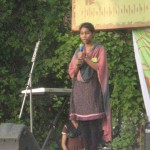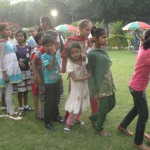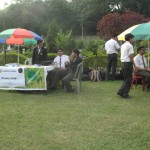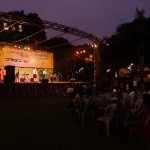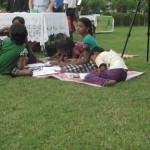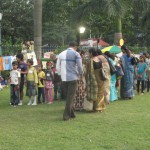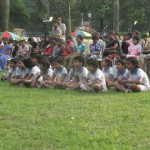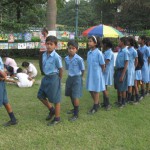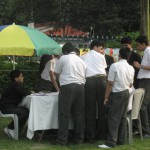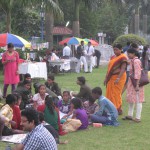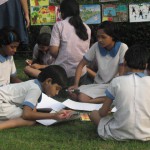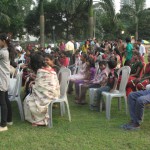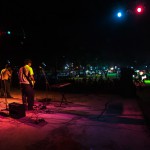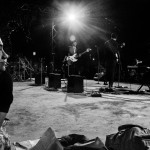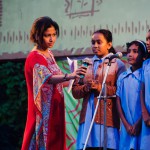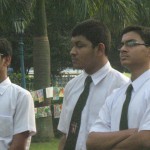On 21st November 2012, children from the Nabadisha centres and six city schools came together and spent a day at Mohur Kunja—telling stories, playing games and painting, in short, having a gala time. And all this precipitated as a result of a wish— to celebrate Children’s Day with the underprivileged children who are supported by Nabadisha, a Kolkata Police project that provides primary education to these children in sixteen police stations in the city.
PeaceWorks collaborates with Nabadisha through the project Share Stories Open Minds and uses the creative medium of storytelling to affect minds. We do an hour-long storytelling session once every week with help of a dozen of committed volunteers. We have been conducting these sessions in eight centres for last two years. The impact of the project had been such that a few months into the sessions, and already, the children wanted to tell stories. This inspired us. And, Golpo Mela was born.
Golpo Mela opened with Megha’s welcome address. She introduced the project and the impetus behind the Mela and then invited one of our longstanding volunteers Ashok Chaturvedi onto the stage. Ashok Da had joined the project at its very inception. He shared his experiences and ideas—
When Megha told me about this project, I felt deeply inspired and moved. Here was an opportunity to do something meaningful and different. The project uses a medium that is familiar to most. All of us have heard stories as children— from our grandparents and parents and have drawn our ideals and philosophies from there. Then as parents and later as grandparents we narrated these stories to our future—our children and grandchildren. This is how we have kept values, belief systems and traditions alive. But what about these children, don’t they need it as well? Perhaps they require it much more than we do.
True, stories don’t merely cart values; at root they are a gift of hope.
And the children shared this gift with all of us—twenty-four children from the Nabadisha Centres and the Child Care Centre and three selected out of ‘Radio Mirchi Storytellers Hunt’ came on the stage and narrated short stories. Lively and animated, these stories were pure joy for us—volunteers, PeaceWorks facilitators and centre coordinators, who spent days training them for the event. Jasmine, coordinator of Beniapukur Nabadisha Centre, articulated in words what most of us were too overwhelmed to express—
I saw Zaiba’s performance; she is just five and almost lisped her story. But she was so excited! Her gestures, her articulation and even the little jig she did was so…so heartwarming.
The quality of their performance varied, yet at the end of it, every child looked infinitely satisfied and tad confident.
Storytelling was followed by three band performances by the students of The Heritage School and La Martiniere for Boys. They enlivened the ambience with their perky music. And then a few students from La Martiniere for Boys put up an impromptu skit. They modified the concept of stage and dragged the story slam offstage. Accompanied by a mandolin and loads of creativity, they played to the gallery and gathered resounding applause while giving Golpo Mela its very own carnivalesque street show! The two comperes Purbani Das and Bonisha Bhattacharya kept time and facilitated a smooth flow of events and seamlessly managed the performances be it on or off the podium.
Meanwhile, offstage six Kolkata schools—La Martiniere For Boys, The Heritage School, Vidyanjali International, Modern High School for Girls and Chowringhee High School were busy with their game stalls. The games revolved round the idea of storytelling— ‘Puzzle the Story’, ‘Print your Mug’, ‘Quiz’, ‘Pin the Mouse’, ‘Pinocchio’s Nose’ and many more. Soon each of these stalls had children cued up to play the games. Children from Rainbow, NGO supported by Loreto Sealdah, and Suryakiran, supported by The Heritage School, joined the Nabadisha children and excitedly participated in everything that the Mela had to offer them. The joy of answering a quiz question, or solving a puzzle or even aiming at an elongated nose and then getting a prize for it is known only to one endearing specie—little children.
There were many other things in the offing— several books stalls, a kiosk taken by The American Centre and a Patachitra Corner. Then there was a Reading Corner where the Nabadisha (Vikramshila) children read out from popular children’s books. However, there was one corner that buzzed like a bee’s hive—the Art Corner, where artist and art teacher, Arunima Choudhury and Romi Mazumdar, conducted an open-air art workshop. Children flocked to the corner in such numbers that soon the corner spilled out and spread across the dew wet Mohur Kunja ground, which looked like one giant spread. Nabadisha children and school students were often seen working together on one big chart paper—making interesting collages or painting posters round the theme of Peace. At one glance it seemed as if these children, who came from such varied background, had gathered together for one deep cause. Was it peace? Or tolerance? Perhaps mutual respect and sharing? Or, just, may be dollops of Hope scooped in cones of fun and humour.
A Report by Shailza Rai

